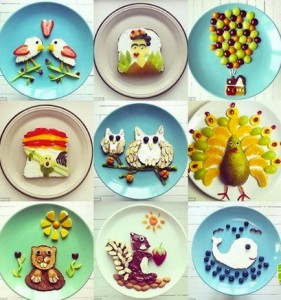Food As Art Research
Can food be an art? As for me, the answer is Yes. People can taste various foods from different area, different religion, and different producing process. How exciting it is. The characteristic can also make a dish become unique and special. Someone might argue about the food is just for physical need and cannot be count as a work of art.
In the Washington post’s article, The Big Debate: Can Food Be Serious Art? It simply lists the pros and cons about whether food can be an art. The “can’t” and “can so” mention all the key point about discussing the food. The “can’t ” point out the general thinking about why food can’t be a art and the food just do the functional job for people. On the other hand, the “ can so”, Gopnik, use the elBulli restaurant as an example to support the point why food can be art.
Ellizabeth Tefler mention that: “perhaps aesthetic qualities are capacities which some things have to arouse reactions of a certain kind in us” and “it is generally agreed that there can be aesthetic reactions to tastes and smells.” (p.18) Food can give people’s esthetic reactions before they taste the dish and after taste the dish. Gopnik states that the customer can enjoy the Michelin level’s dish from the elBulli restaurant. Someone would argue that food just feed people and can’t count as art. So, how people can set a range to judge the food can be a work of art. The term “Michelin Star” is a hallmark of fine dining quality and restaurants around the world tout their Michelin Star status. (Wikipedia) In some extent, people already set a standard or category for food art. Like music, there are different type of music, classical music, country music, and jazz music. The food also can be created by different category. People can just choose a Michelin restaurant to enjoy a food art. That is a popular way for people to find a food art.
Also, some people argue that: “food, its goal is to feed people, so it’s too functional to count as serious art.” The counterargument is “Paintings, photos and videos have their “functional” versions, too. The function is just the scaffold that food-art is built around. ElBulli’s “art” goes way beyond the calories it delivers.” The counterargument touches me a lot. Nowadays, we can see some artist use food to create a painting. So, if the painting can be eatable, this painting is not an art? Can we define that something, which can be eatable, is not an art? Clearing, it can’t.
Furthermore, Tefler claim “because people have to eat them to appreciate them, and because each person necessarily eats a different part of the dish, it might seem that in the sphere of food no one can appreciate a complete work of art, and no two people can appreciate the same one.”(p. 23) There is similar point in the post said: “It can be experienced by only a tiny number of people.” The counterargument is “You don’t measure an art form by the size of its audience. Way fewer than 8,000 of their contemporaries ever heard most of what Bach or Mozart wrote; almost no one looked at Vermeer in his own day.” It is so right that we can measure an art by its audience. There is an interesting example happened around us. A concert ticket cost around $500, which play by a world famous violinist. However, when the world famous violinist plays on the street, there are few people stop by. Can we say the song that was play by this famous artist is not a process of promoting art? Can we judge this by the number of audience?Dissanayake also claim that: “Disinterest implied that viewers could appreciate any art, even the artwork of eras or cultures far removed from their own, whether or not they understood the meaning the works had for the people who made and used them. In this sense, art was ‘universal.’” (Dissanayake, p. 18) We cannot simple judge the food by the basic functional it has. We can deny that food is edible, but it is one of the functions of food. Like painting, it can promote the educational function, decorating function, and reflecting the reality function. Therefore, we should have the art spirit to appreciate the food. The Disinterest attitude is the key thing we should have when we appreciate an art. The bias would stop our feet to find art.
work site:
Dissanayake, E. (1991). What is art for? In K. C. Caroll (Ed.). Keynote adresses 1991 (NAEA Convention), (pp.15-26). Reston, VA: National Art Education Association.from http://blogs.uoregon.edu/aad250shuette/files/2010/09/2-dissanayake.pdf
Gopnik, B. (2009, September 23). The Big Debate: Can Food Be Serious Art? The Washington Post [On-line Newspaper]. Retrieved October 21, 2012 from http://www.washingtonpost.com/wp-dyn/content/article/2009/09/22/AR2009092203137.html
Tefler, E. (2002). Food as Art. In Neill, A. & Riley, A. (eds.) Arguing About Art: Contemporary Philosophical Debates (2nd ed., Chap. 2). New York, NY: Routledge.fromhttp://blogs.uoregon.edu/aad250shuette/files/2010/09/3-tefler.pdf
